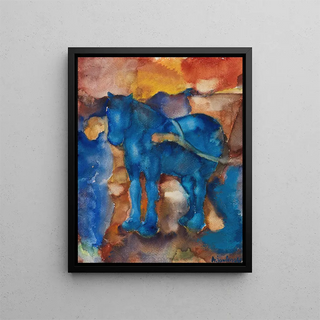Art print | Blue horse - Alexej von Jawlensky


View from behind

Frame (optional)
In the vast panorama of modern art, few works stand out for their chromatic intensity and emotional depth like "Blue Horse" by Alexej von Jawlensky. This iconic piece, created in 1912, immerses the viewer in a universe where color and form intertwine to express complex feelings. The horse, the central figure of the composition, symbolizes both power and freedom, while evading realistic representation. It is an invitation to introspective contemplation, where every shade of blue resonates with a spiritual vibration. The art print "Blue Horse" by Alexej von Jawlensky allows access to this aesthetic experience, offering a new perspective on the work of this major artist.
Style and uniqueness of the work
"Blue Horse" is distinguished by its bold style and vibrant palette. Jawlensky, influenced by the expressionist movement, uses pure colors and simplified forms to transcend reality. The dominance of blue, combined with touches of yellow and red, creates an atmosphere that is both soothing and dynamic. The horse, stylized and almost abstract, appears to float in an undefined space, a choice that evokes spirituality and the soul of the animal. This innovative approach challenges the artistic conventions of its time, paving the way for a new perception of nature. Every brushstroke, every nuance contributes to a visual narrative that invites personal interpretation, making this work a true masterpiece of modern expression.
The artist and his influence
Alexej von Jawlensky, an emblematic figure of expressionism, marked the early 20th century with his unique approach to painting. Born in Russia, he settled in Germany, where he became an active member of the "Der Blaue Reiter" group. This collective, which advocates art as a means of spiritual expression, profoundly influences his creation. Jawlensky is interested in representing emotions rather than merely imitating nature. His work, rich in colors and abstract forms, has inspired many contemporary and later artists, contributing to the emergence of movements such as abstraction.

Matte finish

View from behind

Frame (optional)
In the vast panorama of modern art, few works stand out for their chromatic intensity and emotional depth like "Blue Horse" by Alexej von Jawlensky. This iconic piece, created in 1912, immerses the viewer in a universe where color and form intertwine to express complex feelings. The horse, the central figure of the composition, symbolizes both power and freedom, while evading realistic representation. It is an invitation to introspective contemplation, where every shade of blue resonates with a spiritual vibration. The art print "Blue Horse" by Alexej von Jawlensky allows access to this aesthetic experience, offering a new perspective on the work of this major artist.
Style and uniqueness of the work
"Blue Horse" is distinguished by its bold style and vibrant palette. Jawlensky, influenced by the expressionist movement, uses pure colors and simplified forms to transcend reality. The dominance of blue, combined with touches of yellow and red, creates an atmosphere that is both soothing and dynamic. The horse, stylized and almost abstract, appears to float in an undefined space, a choice that evokes spirituality and the soul of the animal. This innovative approach challenges the artistic conventions of its time, paving the way for a new perception of nature. Every brushstroke, every nuance contributes to a visual narrative that invites personal interpretation, making this work a true masterpiece of modern expression.
The artist and his influence
Alexej von Jawlensky, an emblematic figure of expressionism, marked the early 20th century with his unique approach to painting. Born in Russia, he settled in Germany, where he became an active member of the "Der Blaue Reiter" group. This collective, which advocates art as a means of spiritual expression, profoundly influences his creation. Jawlensky is interested in representing emotions rather than merely imitating nature. His work, rich in colors and abstract forms, has inspired many contemporary and later artists, contributing to the emergence of movements such as abstraction.






